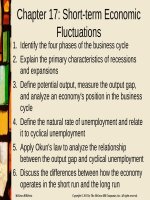Lecture Principles of economics (Asia Global Edition) - Chapter 16
Bạn đang xem bản rút gọn của tài liệu. Xem và tải ngay bản đầy đủ của tài liệu tại đây (727.98 KB, 39 trang )
Inflation and the Price Level
Chapter 16
McGrawHill/Irwin
Copyright © 2015 by McGrawHill Education (Asia). All rights reserved.161
Learning Objectives
1.
2.
3.
4.
5.
Explain how the consumer price index (CPI) is
constructed and use it to calculate the inflation rate
Show how the CPI is used to adjust dollar amounts
to eliminate the effects of inflation
Discuss the two most important biases in the CPI
Distinguish between inflation and relative price
changes to find the true costs of inflation
Summarize the connections among inflation,
nominal interest rates, and real interest rates
162
Keeping up with Grandpa
•
Prices of goods change over time
–
–
•
Baseball salaries
–
–
•
•
Adjust values, incomes, or spending for change in
prices
Constant purchasing power
Bruce Lee earned US$500,000 in 1973
Jackie Chan earned US$15 million in 2007
Inflation increases uncertainty when planning for
the future
Consider costs of inflation
163
Measuring the Price Level
•
•
The Consumer Price Index (CPI) is a measure
of the cost of living during a particular period
The CPI measures
–
–
•
The cost of a standard basket of goods and
services in a given year
relative to the cost of the same basket of goods and
services in the base year
Base year for the CPI changes periodically,
normally it changes every five years
164
Calculating the CPI
2013 Spending
Monthly Cost in 2013
Rent (2 bedroom apartment)
$500
Hamburgers (60 at $2 each)
120
Movie tickets (10 at $6 each)
60
Monthly expenditures
2018 Spending
Rent (2 bedroom apartment)
Hamburgers (60 at $2.50 each)
Movie tickets (10 at $7 each)
Monthly expenditures
$680
Monthly Cost in 2018
$630
150
70
$850
165
Calculating the CPI
•
CPI is the ratio of the cost of the basket of goods
in the current year to the cost in the base year
–
–
•
Base year cost $680
2018 cost $850
CPI = (850 / 680) (100) = 1.25
Cost of living in 2018 is 25% higher than in 2013
–
–
–
CPI for the base year is always 1
CPI for a given period is the cost of living in that
period relative to what it was in the base year
Statistical authorities around the world use CPI as a
percentage – the ratio times 100
166
Cost of Living
CPI = 1050 / 800 = 1.31
2013 Spending
Monthly Cost in 2013
Rent (2 bedroom apartment)
$500
Hamburgers (60 at $2 each)
120
Movie tickets (10 at $6 each)
60
Sweaters (4 at $30)
Monthly expenditures
2018 Spending
Rent (2 bedroom apartment)
Hamburgers (60 at $2.50 each)
Movie tickets (10 at $7 each)
Sweaters (4 at $50)
Monthly expenditures
120
$800
Monthly Cost in 2018
$630
150
70
200
$1,050
167
Price Index
•
•
•
A price index measures the average price of a
given class of goods and services relative to the
price of the same goods and services in a base
year
CPI measures the change in consumer prices
Other indices
–
–
–
Core inflation is CPI without energy and food
Producer price index
Import / export price index
168
•
•
•
Inflation
The rate of inflation is the annual percentage
change in the price level
Inflation of China in 2012 = (2.68–2.61)/2.61 = 0.0268 = 2.7%
When inflation rates are negative there is deflation
CPI of Selected Countries
United
Japan Singapore Thailand
States
Year
China
2008
2.41
1.02
0.99
0.94
2.15
2009
2.40
1.01
1.00
0.93
2.15
2010
2.48
1.00
1.03
0.96
2.18
2011
2.61
1.00
1.08
1.00
2.25
2012
2.68
1.00
1.13
1.03
2.30
169
Adjusting for Inflation
•
•
A nominal quantity is measured in terms of its
current dollar value
A real quantity is measured in physical terms
–
•
Quantities of goods and services
To compare values over time, use real quantities
–
Deflating a nominal quantity converts it to a real
quantity
•
Divide a nominal quantity by its price index to
express the quantity in real terms
1610
Family Income in 2013 and 2018
•
Can a family buy more with $40,000 in income in
2013 or with $44,000 in 2018?
–
–
–
–
2010 is the base year for the CPI
Deflate nominal income in both years to get real income
Compare real income
$40,000 in 2013 has the greater purchasing power
Year
Nominal Income
CPI
Real Income
2013
$40,000
1.00
$40,000/1.00 = $40,000
2018
$44,000
1.25
$44,000/1.25 = $35,200
1611
Movie Stars
•
Compare Bruce Lee’s earnings with Jackie Chan’s
–
–
•
Requires a CPI series that includes 1973 and 2007
•
U.S. CPI using 1982 – 1984 as base year
Jackie Chan had higher real salary
Does not convey information about relative incomes
–
–
Economic and Oil crisis in 1973
Multi-million dollar earnings common for move stars in
2007
Player
Year
Nominal Salary
CPI
Real Salary
Bruce Lee
1973
US$ 500,000
0.444
US$ 1.13 Mn
Jackie Chan
2007
US$ 15 Mn
2.073
US$ 7.24 mn
1612
Real Wages
•
The real wage is the wage paid to the worker
measured in terms of purchasing power
–
•
The real wage for any given period is calculated by
dividing the nominal wage by the CPI for that period
US production worker wages
–
–
CPI uses 1982 – 1984 as base year
Real wages stayed the same between 1970 and 2010
despite the fact that the nominal wage in 2010 was 5.5
times the nominal wage in 1970
Year
Average Wage
CPI
Real Average Wage
1970
$3.40
0.39
$3.40 / 0.39 = $8.72
2010
$19.00
2.18
$19.00 / 2.18 = $8.72
1613
Production Workers’ Wages,
1960 - 2010
1614
Indexing
•
Indexing increases a nominal quantity each
period by the percentage increase in a specified
price index
–
•
Indexing prevents the purchasing power of the
nominal quantity from being eroded by inflation
Indexing automatically adjusts certain values,
such as Social Security payments, by the
amount of inflation
–
If prices increase 3% in a given year, the Social
Security recipients receive 3% more
•
–
No action by Congress required
Indexing is sometimes included in labor contracts
1615
Adjusting for Inflation
•
An indexed labor contract
–
First year wage is $12 per hour
•
–
•
Real wages rise by 2% per year for next 2 years
Relevant price index is 1.00 in first year, 1.05 in the
second, and 1.10 in the third
Nominal wage is real wage times the price index
Year
1
2
3
Real Wage Price Index
$12.00
1.00
$12.24
1.05
$12.48
1.10
Nominal Wage
$12.00
$12.85
$13.73
1616
Minimum Wage
•
In some countries, the governments set the
national minimum wage in nominal terms
–
Publicized debate results in periodic increases
•
•
•
Indexing would be simpler and less controversial
Politicians appear to benefit from the debate
In the United States, minimum wage increased
15 times between 1970 and 2008
–
Real minimum wage has decreased by about onethird in that period
1617
CPI and Inflation
•
•
CPI and other indexes influence policy decisions
and wage increases
1996 report said CPI overstates U.S. inflation by
1 to 2 percentage points a year
–
–
Unnecessarily increases government spending
Underestimates increase in the standard of living
•
Suppose CPI indicates 3% inflation when cost of
living actually increases 2%
–
•
Real income increases 1%
Changes to calculations made since report to
improve the quality of the CPI calculations
1618
CPI Quality Adjustment Bias
•
One important bias in the CPI is its
measurement of price changes but not quality
changes
–
PC with 20% more memory has 20% higher price
•
–
•
If no adjustment is made for quality, PC's
contribution to the CPI will be 20%
Adjusting for quality is difficult
–
–
•
Not the same PC as the one with less memory
Large numbers of goods
Subjective differences
Incorporating new goods is difficult
–
No base year price for this year's new goods
1619
CPI Biases
•
CPI uses a fixed basket of goods and services
–
–
•
When the price of a good increases, consumers buy
less and substitute other goods
Failing to account for substitution overstates inflation
Example: base year cost of market basket
Item
Coffee (50 cups)
Tea (50 cups)
Donuts (100)
Total
2013 price
$1.00
$1.00
$1.00
2013 Spending
$50.00
$50.00
$100.00
$200.00
1620
CPI Substitution Bias
•
In 2018, coffee and scones are more expensive
–
–
Buying exactly the same basket of goods costs
$300, compared to $200 in 2013
CPI = 300 / 200 = 1.50
Item
Coffee (50 cups)
Tea (50 cups)
Donuts (100)
Total
2018 price
$2.00
$1.00
$1.50
2018 Spending
$100.00
$50.00
$150.00
$300.00
1621
CPI Substitution Bias
•
Actually, consumer substitutes tea for coffee
–
•
•
Scone purchases constant
True CPI for consumer is 250 / 200 = 1.25
CPI estimate of 1.50 is 20% higher than the
consumer's experience
Item
Coffee (00 cups)
Tea (100 cups)
Donuts (100)
Total
2018 price
$2.00
$1.00
$1.50
2018 Spending
$0.00
$100.00
$150.00
$250.00
1622
The Costs of Inflation
•
The price level is a measure of the overall level
of prices at a particular point in time
–
•
The relative price of a specific good is a
comparison of its price to the prices of other
goods and services
–
•
Measured by a price index such as the CPI
Calculated as a ratio
Suppose we have a one-time doubling of the
gas price
–
–
Overall price level and inflation increase by a small
amount
The increase in the relative price of gasoline is large
1623
Relative Prices
•
•
Relative prices can change markedly without
corresponding changes in inflation
Summer prices
1624
Inflation and Relative Prices
Year
CPI
Inflation
2013
2014
1.20
1.32
10%
2015
1.40
6%
Oil Price
Change
Relative Price
of Oil
8%
8%
-2%
2%
1625









